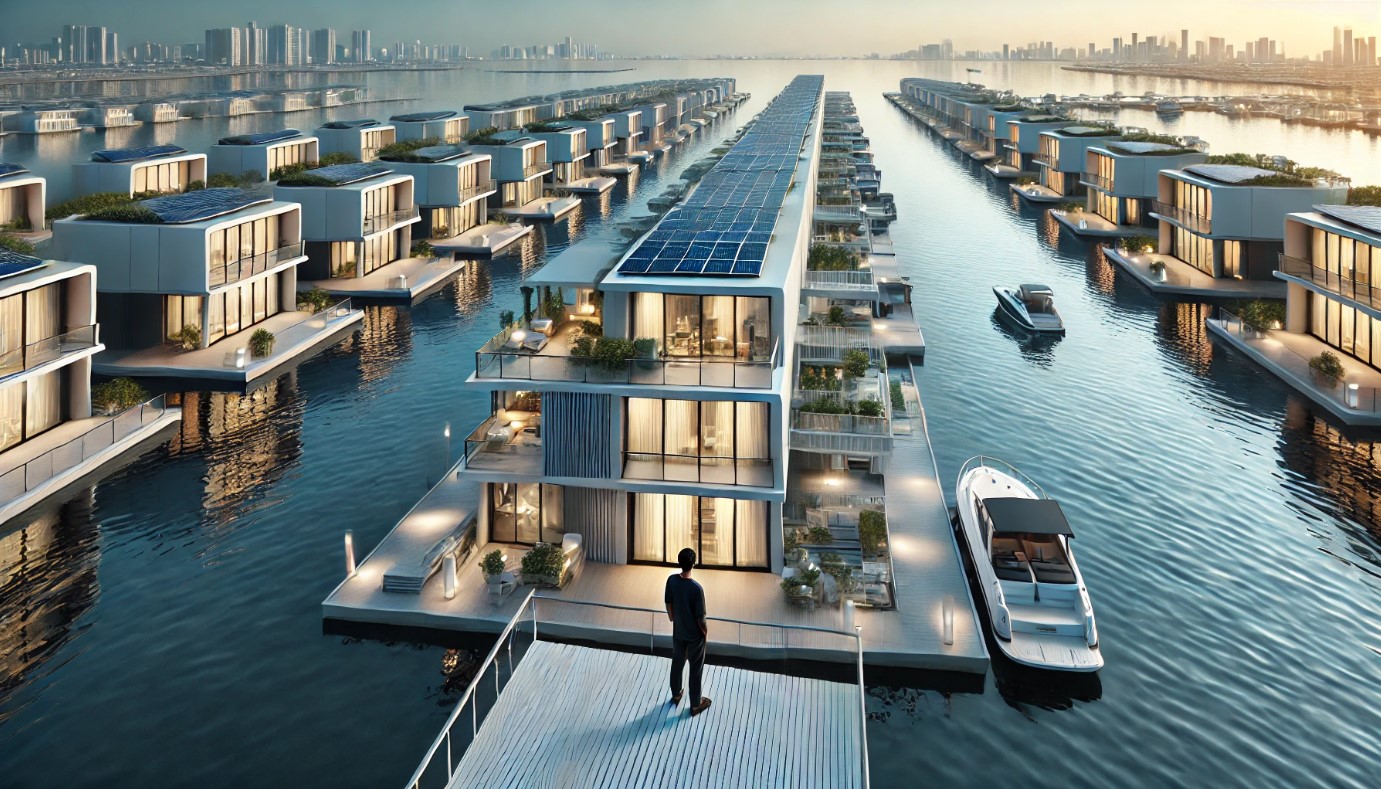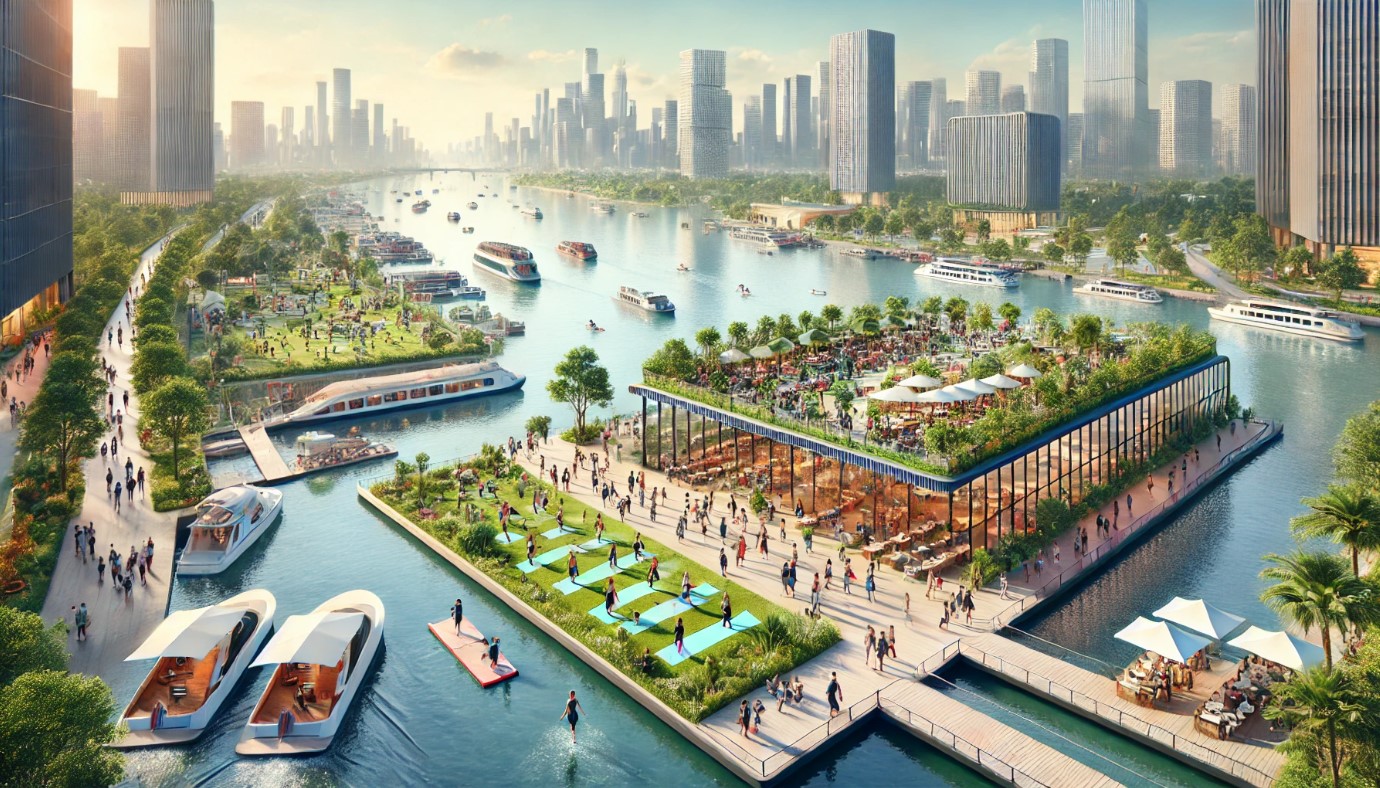As the vision of floating cities on oceans and seas becomes increasingly tangible, the need for sustainable and efficient transportation solutions for these communities is paramount. Eco-friendly mobility options such as water trams, water taxis, bikes, ground effect vehicles, and hydrofoil vehicles are essential to ensuring that residents can navigate their floating habitats in a manner that aligns with the overarching goals of sustainability and environmental stewardship. This article explores how these innovative transportation modes can serve sea-based communities and contribute to the realization of fully sustainable floating cities.

The Backbone of Public Transport
Water trams are set to become the backbone of public transportation in floating cities. These vessels, designed to operate on fixed routes, can efficiently ferry large numbers of passengers between different parts of the city and its surrounding areas. By using clean energy sources such as electricity, solar power, or hydrogen fuel cells, water trams can offer a zero-emission solution to public transport.

The design of water trams prioritizes accessibility, ensuring that all residents, including those with disabilities, can easily board and disembark. Spacious interiors, comfortable seating, and amenities such as Wi-Fi make water trams a convenient and attractive option for daily commuting. With regular and reliable schedules, these trams can significantly reduce the reliance on personal vehicles, thereby decreasing traffic congestion and minimizing the carbon footprint of the community.

Water Taxis
For more personalized and flexible transportation needs, water taxis offer a practical solution. These smaller, nimble vessels can operate on-demand, providing point-to-point service that complements the fixed routes of water trams. Water taxis are ideal for short trips or for reaching destinations that are not directly served by public transport routes.

Like water trams, water taxis can be powered by eco-friendly energy sources, ensuring that they contribute to the sustainability goals of floating cities. The convenience of water taxis can also encourage residents to opt for shared rides instead of using private boats, further reducing emissions and promoting a culture of shared, sustainable mobility.

Promoting Active and Sustainable Transport
Bicycles represent one of the most sustainable and health-promoting forms of transportation. In floating cities, bikes can play a crucial role in local mobility, offering residents a zero-emission option for short-distance travel. Dedicated bike lanes and paths can be integrated into the design of floating cities, ensuring safe and efficient routes for cyclists.

To enhance convenience, bike-sharing programs can be established, allowing residents and visitors to rent bikes for short periods. These programs can utilize smart technology, enabling easy access to bikes through mobile apps and automated docking stations. By promoting cycling, floating cities can not only reduce their environmental impact but also encourage a more active and healthy lifestyle among their inhabitants.

Efficient and High-Speed Transport
Ground effect vehicles (GEVs), also known as wing-in-ground effect vehicles, offer an efficient and high-speed transport option for sea-based communities. These vehicles fly just above the water’s surface, utilizing the ground effect to achieve lift and reduce drag. This unique mode of transportation combines the speed of an aircraft with the efficiency of a boat, making it an ideal solution for medium to long-distance travel within and between floating cities.

GEVs can be powered by clean energy sources, such as electric or hybrid engines, further enhancing their eco-friendly credentials. Their ability to operate just above the water surface reduces fuel consumption and emissions, making them a sustainable alternative to traditional marine or aerial transport.

Cutting Through the Waves
Hydrofoil vehicles represent another innovative solution for eco-friendly mobility in floating cities. These vessels are equipped with wing-like structures (hydrofoils) mounted below the hull.

As the vehicle speeds up, the hydrofoils lift the hull above the water, significantly reducing drag and allowing for higher speeds with greater fuel efficiency.

Hydrofoil vehicles can be used for both public transport and private travel, offering a fast and efficient way to navigate the waters surrounding floating cities.

Powered by electric or alternative clean energy sources, hydrofoils contribute to reducing the overall environmental impact of sea-based transportation.

Integrating Sustainable Mobility into Urban Planning
The success of eco-friendly mobility in floating cities hinges on thoughtful urban planning and integration. Transportation hubs should be strategically located to facilitate easy transfers between water trams, water taxis, bikes, GEVs, and hydrofoil vehicles. Urban planners must ensure that all parts of the city are well-connected, with seamless transitions between different modes of transport.

Additionally, the development of these transportation systems should be accompanied by public awareness campaigns to educate residents about the benefits of sustainable mobility and encourage their adoption. Incentives such as discounted fares for regular users and promotional events can further boost the popularity of eco-friendly transport options.

Eco-friendly mobility solutions such as water trams, water taxis, bikes, ground effect vehicles, and hydrofoil vehicles are integral to the sustainable development of floating cities. By providing efficient, zero-emission transportation options, these systems can help reduce the environmental impact of sea-based communities while enhancing the quality of life for residents. As the concept of floating cities moves closer to reality, embracing these innovative transport modes will be key to creating resilient, vibrant, and sustainable urban environments on the ocean.




